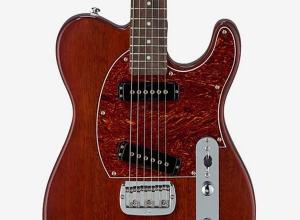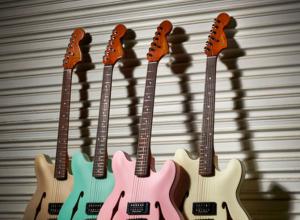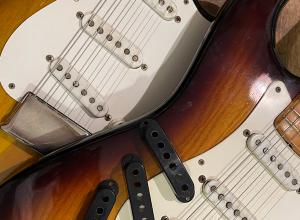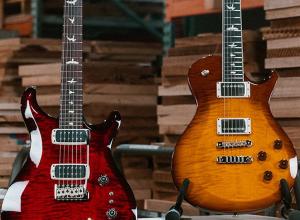Infatti, entrando più nel dettaglio, scopriremo che l’anno “1954” ha visto uno sviluppo progressivo, veloce e decisivo del modello in un breve lasso di settimane, mesi, che ha affinato la forma e le caratteristiche della chitarra più innovativa mai costruita fino ad oggi.
Per questi motivi, per i veri “nerd” appassionati (come chi scrive), è davvero interessante approfondire ed analizzare le differenti incarnazioni della Fender Stratocaster lungo l’anno 1954.
In passato l’unica distinzione che veniva fatta era tra due periodi fondamentali, un primo di “pre-produzione”, (che incorpora quell’insieme di strumenti realizzati prima che Fender Sales formulasse una richiesta formale per produrre il nuovo modello), ed un secondo periodo “di produzione”, che corrispondeva appunto a quel gruppo di strumenti realizzato per soddisfare la richiesta di Fender Sales.
Questa dicotomia è troppo semplicistica, infatti la quantità di migliorie e modifiche apportate sullo strumento nel corso del 1954 non può essere trascurata, ed è anzi estremamente interessante perché gli strumenti prodotti variano in maniera sostanziale, sia nei tecnicismi che nella sostanza, con un risultato finale in termini di suono molto differente.
Prima di tutto, è importante chiarire che non è corretto parlare di “prototipi” quando si parla di Stratocaster prodotte nel 1954. Infatti, la fase di sviluppo del nuovo modello Fender avvenne nel 1953, basti pensare che i primi 100 manici furono prodotti nel Marzo del 1953, e i primi body completati nel Maggio del 1953.
L’idea di Fender era proprio quella di presentare la nuova chitarra al NAMM show di quell’anno.
Già dal gennaio 1954 infatti, tutte le caratteristiche principali della chitarra erano già state progettate e costruite.
Il primo lotto di produzione di Fender Stratocaster, realizzato tra gennaio e maggio 1954, aveva una serie di caratteristiche uniche, che sono state aggiornate o abbandonate più tardi nello stesso anno.
Oggi siamo orgogliosi di avere sulla nostra “Vintage Vault Bench”, una di queste rare chitarre, una Fender Stratocaster “Trem Cover” del maggio 1954, numero di serie #0129.
Il Manico
Il bellissimo manico in acero fiammato monoblocco con “skunk stripe” di noce sul retro per coprire il truss rod, è stato realizzato nel maggio 54, come mostra la data a matita sul tacco (TG 5-54).
La chitarra è stata suonata tantissimo, e presenta un’usura naturale molto estesa lungo la tastiera ed il retro del manico, dove la finitura laccata si è consumata creando un effetto “seta” molto confortevole al tatto, ed a parte un refret professionale ed altre meccaniche utilizzate per un breve periodo, rimane in condizioni originali senza riparazioni o restauri fatti al legno o alla finitura.
Il “vibe” di questo manico così suonato è fantastico, dall’oro della decal Fender che si è ossidato nel tempo alla finitura invecchiata e consumata, ogni centimetro del manico mostra fieramente la sua età
Il profilo del manico è molto simile a quello tipico dell’era delle “nocaster”, una sezione “D” grande e piena, molto comoda da suonare.
Il Body
Il body, composto da 3 pezzi di frassino con bellissima figurazione, ha una lunga lista di caratteristiche uniche, dettagli e scelte costruttive che Fender avrebbe scartato a partire dal luglio / agosto 1954, appena due mesi dopo la costruzione di questa chitarra.
Prima di tutto, la verniciatura. La finitura sunburst di Fender fu una rivoluzione per la Fullerton Factory, infatti negli anni precedenti la finitura standard era quella “Blonde” vista sulle chitarre Telecaster, Esquire, etc. Quindi il nuovo modello, la Stratocaster “contoured body”, doveva avere una finitura unica, nuova di zecca, un elegante sunburst.
Nel primo semestre del 1954 il sunburst fu realizzato con caratteristiche ben precise.
Prima di tutto, un’applicazione spessa che garantisse una lucidatura perfetta, ottenuta con una finitura molto resistente e molto trasparente, che mettesse in risalto la bellezza delle venature del legno. In alcune chitarre la finitura è così trasparente che possiamo ancora vedere il grain anche sotto la parte “scura” del sunburst se la mettiamo sotto una luce forte o sotto la luce diretta del sole.
I colori di questa prima incarnazione della finitura Fender Sunburst sono di nuovo unici e tipici di questo primo periodo di produzione.
Per cominciare, il “colore” centrale…non c’è! Esatto, in inglese questo tipo di sunburst viene definito “no yellow”, perché fondamentalmente quello che vediamo nel centro del body è il colore naturale del frassino, ambrato dal tempo. Lungo i contorni del body invece il sunburst sfumato è ottenuto con una base marrone e non veniva usato un vero e proprio colore nero, solo una tinta marrone più scura che “chiude” e delinea la forma del corpo.
La finitura finale è piuttosto spessa, dovuta alle diverse mani di smalto trasparente applicate sulla parte superiore, necessarie per chiudere i pori del frassino e per creare una superficie liscia ed adeguata ad una perfetta lucidatura finale. La finitura finale non è affatto simile a quella sottile che siamo abituati a vedere nelle stratocaster degli anni ’50, e molto probabilmente si trattava di un vero e proprio smalto (enamel) disponibile all’epoca.
Un’altra caratteristica unica di queste finiture è che non presentano alcun “weather checking”, quelle mitiche crepe che abbiamo imparato ad apprezzare sulle chitarre storiche e che tanto di moda vanno sui modelli “relic”.
Altre caratteristiche uniche della costruzione del corpo sono l’assenza del “worm route”, (il canale per i cavi dei pickups alla base della cavità del pickup al ponte) dovuta alla diversa profondità della tasca del manico ed alla conseguente maggiore altezza delle corde; la presenza della data a matita nella tasca del manico (come era procedura comune per tutti i modelli tra il 1950 e il 1953) ed un particolare sistema di “nail holes”, solitamente presenti solo sul fronte del body, qui invece anche sul retro, sotto alla piastra del manico.
L’hardware
Tutte le parti metalliche della chitarra sono quelle originali, dalle meccaniche Kluson “no line” alle sellette “pat pend” del tremolo, dalle viti jack cup più grandi alla piastra del manico. Un altro dettaglio unico è il blocco del tremolo, che presenta segni di lavorazione unici che lo differenziano da quelli successivi realizzati nel 1954.
Le parti in plastica
La chitarra presenta un battipenna bianco a 1 strato e montava i primi, fragilissimi, kit copri-pickup e manopole “short skirt”. Questi si rompevano così facilmente che Fender già offriva ai clienti sostituzioni gratuite con parti nuove a partire da Ottobre del 1954. Questa chitarra ora è dotata di repliche accurate delle cover pickups e delle manopole originali, realizzate con i materiali e le specifiche corrette, e sono l’unica parte “non originale” ora presente sullo strumento.
Poi c’è l’incredibile “trem cover”, realizzata in una plastica a 1 strato più spessa rispetto a quelle successive, che mostra questi 4 numeri, impressi in maniera indipendente, che hanno fatto la storia.
C’è tuttora un dibattito aperto in merito a quante “trem cover” stratocaster siano state prodotte. Quello che sappiamo per certo è che, a tutt’oggi, quella rinvenuta con numero seriale “più basso” è la 0100, mentre quella con seriale più alto è la 0207.
Ma all’interno della nota “Werner’s list”, importante archivio di numeri seriali Fender, sono stati documentati numeri di trem cover inferiori allo 0100, anche se non abbiamo purtroppo prova fotografica o contezza dello stato attuale di questi strumenti.
L’elettronica
Un’altra caratteristica unica delle prime Stratocaster del 1954 è l’impianto elettronico. A partire dai pickup, realizzati con magneti ALNICO III più morbidi e polo della corda di “RE” rialzato, alla configurazione unica dei potenziometri, con un pot da 250k per il volume datato 1954 e due pots del tono da 100k datati 1953 con condensatore da 0,1 mf.
Gli alberini di metallo dei potenziometri usati in questo periodo, di forma solida a cilindro, sono i principali responsabili delle rotture delle manopole in plastica “short skirt”, le quali, venendo inserite per pressione, ed essendo di materiale molto fragile, si spaccavano in alcuni casi già dalla prima installazione.
Il suono
Abbiamo avuto il privilegio di vedere dal vivo e suonare un certo numero di queste prime Fender Stratocaster “trem Cover”, comprese quelle della straordinaria Collezione Wellstrung di New York, ma anche la numero #0146, #0174 e #0163. Ognuna di queste è a suo modo unica, e, per gli appassionati del “quanto pesa?” la maggior parte di queste erano pesanti, ma il livello qualitativo è sempre stato eccezionale. I manici hanno una bella forma, molto comodi da suonare, e il suono dei primi pickup con i potenziometri dei toni da 100k è assolutamente unico, molto morbido e ricco, e da prova del suo meglio quando si utilizzano scalature di corde più importanti, così come avveniva all’epoca.
[EN] 1954: A Star is Born - Fender Stratocaster “Trem Cover” serial #0129
For the vast majority of people, a “first year” Fender Stratocaster will be labelled just as a “guitar made in 1954” and for many, knowing the year of manufacture will be plenty.
But, when and if we go a little deeper into the subject, we will find out that the iconic “1954” year has seen a progressive, fast and fundamental development of the model in a short span of weeks, months, that refined the shape and features of the most iconic guitar ever built to date.
As a result, the variety of “1954” Strats is worth to be noted and explained in detail.
In older days the only distinction being made was related to those “pre-production” 1954 (made before the first official order from Fender Sales was placed) and the “production” ones, those built to please Fender Sales request.
This dichotomy is too simplistic, infact a number of features were changed in a short period of time, that lead to very different sounding guitars.
First of all, it is safe to say that there was no “prototype” Strats anymore in 1954. The prototype stage of the new Fender Model took place in 1953. By January 1954 infact, all the main features of the guitar have been designed and built already. The very first production batch of Fender Stratocaster, made between January and May 1954, had a number of unique features, that have been either updated or abandoned later in that same year.
Today we’re proud to have on our Vintage Vault Bench, one of these rare guitars, a may 1954 Fender Stratocaster “Trem Cover” number, serial #0129.
The Neck
The beautiful, one piece, solid flamed maple neck with contrasting “skunk stripe” on the back to cover the metal truss rod, has been made in May 54, as the pencilled neck date shows (TG 5-54).
It has plenty of play wear, where the lacquer finish has worn away resulting in a “silky” effect to the playing hand, and aside from a professional refret and other tuners being used at once, it remains in original conditions with no repairs or restorations done to the wood or the finish.
The vibe of this played neck is fantastic, from the golden part of the “Fender” logo in the original decal, which greened out beautifully, to the worn aged finish, every inch of the neck shows fiercely its age.
The neck profile is very similar to a “nocaster” era neck, a big and full “D” section, very comfortable to play.
The Body
The body, made out of a 3 pieces of heavily grained and figured Ash, has a long list of unique features, that Fender would dismiss starting from July/August 1954, just two months after this very guitar was completed.
First of all, the finish. Fender’s sunburst finish was a revolution for the Fullerton Factory, infact in the previous years the standard finish was the “Blonde” seen on the, now famous, Telecaster, Esquire, guitars.
So the new model, the “contoured body” Stratocaster, needed to have a unique, brand new finish, an elegant sunburst. In the very first semester of 1954 the sunburst was sprayed with a thick application and very hard finish, which was very transparent, to show the beauty of the wood grain.
In some guitars the finish is so “see through” that we can still see the grain even under the “dark” part of the sunburst, if we put it under a strong light or under direct sunlight.
The colors of this early incarnation of the Fender Sunburst finish are again unique to this small timeframe, and feature a “no yellow” center color, where we basically see the natural color of the Ash, and then a brown shaded sunburst where there’s no real “Black”, just a darker brown color that outlines the body shape.
The final finish is quite thick, since they applied several coats of clear enamel on top, to create a smooth surface that could have been sanded flat and then polished and buffed without burning through it.
The finish itself is not at all similar to the thin lacquer that we’re used to see in the 50s, and most likely was a enamel based varnish available at the time.
Another unique feature of these finishes is that they won’t check at all, while they do “Amber” over time.
Other unique features of the body construction are the absence of a “worm route”, due to the different neck pocket’s depth and resulting higher neck playing action, body date present in the neck pocket (as was common procedure for all the models between 1950 and 1953) and unique “nail holes” system, where we see also an additional Nail Hole in the body back, under the neck plate.
The Hardware
All the metal parts on the guitar are the original ones, from the “no line” Kluson Tuners to the “pat pend” saddles of the tremolo, from the larger jack cup screws to the neck plate. These earliest tremolo sustain blocks had unique tooling marks that differentiate them from the later ones made in 1954.
The Plastic Parts
The guitar features an original 1-ply white pickguard and used to have the first issued, very fragile, pickup covers and “short skirt” knobs. These broke so easily that Fender was already offering to customers replacements at no cost by the end of 1954. This guitar now is fitted with accurate replicas of the original covers and knobs, made with the correct materials and specs, they are the only “not original to the guitar” part. Then there is the incredible “trem cover”, made of a thicker 1-ply plastic in comparison to the later ones, it shows these 4 indipendently – pressed in – numbers that made history. Apparently these serials started with number #0100 but in Werner’s list trem cover numbers below 0100 have been documented, although not yet seen in the market in recent years.
The Electronics
Another unique feature of the earliest 1954 fender Stratocasters is the Electronics harness. Starting from the pickups, made with softer ALNICO III magnets and raised “D” polepiece, to the unique pots configuration, with a 1954 dated 250k volume pot, and two 1953 dated 100k tone pots with 0.1mf tone capacitor. All these pots had “solid shafts” that were responsible for the many issues they had with the newer “pressed in” plastic knobs.
The Sound
We’ve had the privilege of handling and playing a number of these early “trem Cover” Fender Stratocasters, including those in the outstanding Wellstrung Collection in NYC, but also serials #0146, #0174 and #0163.
Each one of these was unique, and most of these were heavy in weight, but the quality consistency in all of them has been outstanding. The necks have a beautiful shape, very comfortable to play, and the sound of the early pickups with the 100k tone pots is absolutely unique, very mellow and rich, and it shows its best when setup with heavier gauged strings. |
 VINTAGE VAULT
VINTAGE VAULT
 SHG MUSIC SHOW
SHG MUSIC SHOW
 PEOPLE
PEOPLE
 STORE
STORE
 - Privacy - Accordo.it Srl - P.IVA 04265970964
- Privacy - Accordo.it Srl - P.IVA 04265970964
![1954: È nata una stella - Fender Stratocaster “Trem Cover” seriale #0129 [IT-EN] 1954: È nata una stella - Fender Stratocaster “Trem Cover” seriale #0129 [IT-EN]](https://www.accordo.it/cloud-assets/730x450/redazionea5/images/deco/104688_trem-g.jpg)















































